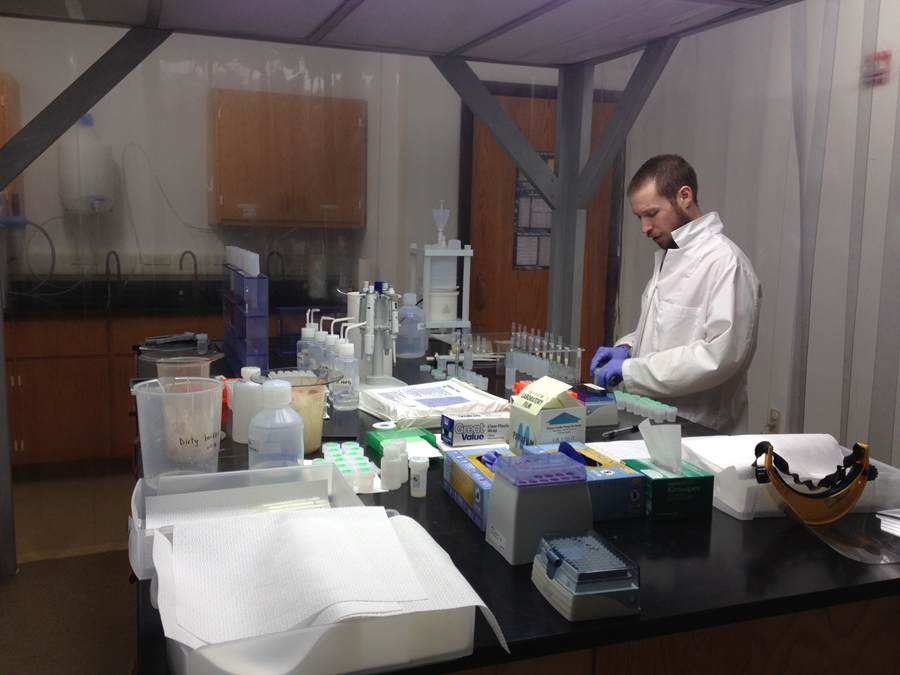
John Samuelsen, an anthropology doctoral candidate and Arkansas Archeological Survey staff member, was awarded $14,750 by the National Science Foundation through a Doctoral Dissertation Research Improvement grant. The project will be overseen by Samuelsen's graduate adviser and survey director, George Sabo III.
Samuelsen's dissertation work involves using lead (Pb) and strontium (Sr) isotopes to help determine the cultural affiliation of certain Native American skeletal remains from southwest Arkansas. Pb is a toxic trace metal that affects the health of biological organisms, but is also useful for determining geographic origins. The isotopic content of Pb and Sr within human and animal tooth enamel, via food chain pathways, reflects the geology of the region in which the organisms grew up. The grant supplies the funds to sample teeth for Pb and Sr isotopes to determine if individuals interred in a prehistoric skull-and-mandible cemetery (A.D. 1253-1399) at the Crenshaw site in southwest Arkansas grew up in the vicinity or in some other region. The remains were originally exposed during the late 1960s by farming practices and by the work of looters.
To accomplish this, Samuelsen is using a newly developed method, the biologically available Pb method, which compares the Pb isotopes of human teeth to Pb isotopes of non-migratory prehistoric animal teeth to determine if they are "local" to southwest Arkansas. Prehistoric animal teeth from states surrounding Arkansas will also be sampled for comparison. Thus, the study will both evaluate the origins of these remains and demonstrate a new method for biological sourcing, which is applicable to a wide variety of other studies and disciplines, such as forensics.
Previous studies have yielded conflicting interpretations of what these human skulls and mandibles reflect. Some research has suggested they are victims of violence who came from outside the region, while other research suggests they represent a local Caddo Indian burial practice of their own ancestors' remains at Crenshaw, an important regional ceremonial mound center. Given its size, the skull-and-mandible cemetery has major implications for how we understand late prehistoric interregional warfare and burial practices in the southcentral U.S.
Lead contamination is common in modern environments, making the execution of Pb related work difficult to conduct without modern Pb contamination. Therefore, Samuelsen will work closely with Adriana Potra of the Department of Geosciences, as some of the isotopic work will be carried out within the metal-free modular Class 100 Radiogenic Isotope Laboratory at the University of Arkansas. The "room inside a room" clean lab is HEPA-filtered and has 400 square feet of workspace. The isotopic data will be collected at the Trace element and Radiogenic Isotope Laboratory (TRaIL) by working with Erik Pollock and Barry Shaulis. The high accuracy isotopic data will be collected on the Nu Plasma multi-collector inductively coupled plasma mass spectrometer (MC-ICP-MS). The drilling of the teeth will require the use of a Leica M80 binocular microscope, housed by Celina Suarez of the Department of Geosciences. The teeth from Arkansas will be supplied by the University of Arkansas Museum and ARAS.
The study is being conducted in consultation with the Caddo Nation of Oklahoma. They have given permission for the isotopic analysis as the study will also serve the practical purpose of determining cultural affiliation for the purposes of Native American Graves Protection and Repatriation Act compliance and to inform and encourage feedback from descendant communities.
Topics
Contacts
John R. Samuelsen, server administrator
Arkansas Archeological Survey
479-575-6539, jsamuel@uark.edu